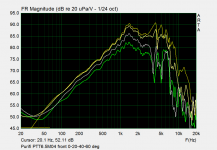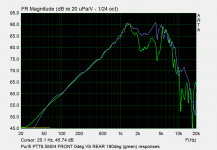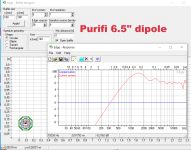Since you are already using DSP I would split the system in two between an actual bass (low and wide) unit and upperbase/trebble (tall and narrow) unit, this will give you a lot of freedom WRT aesthetics and placement. You would have to compensate for the difference in distance between the two units by digitally delaying the closest (from listening position) unit in order to get proper phase alignment
Diffraction effect of a naked 6.5" driver (Sd 133cm^2, OD 176mm) (ie. no baffle)
View attachment 1095499
Simulated response of baffle-less PTT 6.5M-04. 2.83V drive level @ 1m.
View attachment 1095507
Diffraction effect on 6.5" driver on 19cm x 1.2m baffle, driver mounted 40 from top, centered along width. Open/dipole baffle. Mic & tweeter 10cm from top edge (reference axis)
View attachment 1095505
Simulated response PTT 6.5M-04 19cm x 120cm open/dipole baffle; 2.83V @ 1m. 40cm from top edge, centre along width of baffle. Mic 10cm from top edge, on axis with tweeter.
View attachment 1095506
I posted an actual measurement of the PTT 6.5M in post #10, above. If you compare them you can see that the simulated response is quite inaccurate. That is typical - I have not seen a program that can accurately sim the dipole peak area and breakup region. You have to buy the driver and measure it, or find someone else who has done that under the same conditions. Don't trust the sims too much, especially if they include the dipole peak region.
I'm most interested in excursion limited SPL for a driver with Sd of 130cm^2 & 2.9mm in an open baffle of moderate size, VS when it's baffle-less.
I agree Charlie, one needs to measure the drivers in their actual usage. Simulation is only that- a starting point, and shouldn't be used to design a speaker. Though for comparative use between open baffle and baffle-less, I thought it might give some insight.
For one thing, the input I'm using is traced from Purifi's datasheet. And assumes the input data is 2pi (infinite baffle). So If the datasheet data uses an IEC baffle, or any other baffle, then it is not correct. There's also a big chance it's mistake with my use of VituixCad2. So garbage in x user error = big garbage out.
@lrisbo
What were the conditions for measurements of the drivers? eg. baffle dimensions, enclosure, measurement distance.
I agree Charlie, one needs to measure the drivers in their actual usage. Simulation is only that- a starting point, and shouldn't be used to design a speaker. Though for comparative use between open baffle and baffle-less, I thought it might give some insight.
For one thing, the input I'm using is traced from Purifi's datasheet. And assumes the input data is 2pi (infinite baffle). So If the datasheet data uses an IEC baffle, or any other baffle, then it is not correct. There's also a big chance it's mistake with my use of VituixCad2. So garbage in x user error = big garbage out.
@lrisbo
What were the conditions for measurements of the drivers? eg. baffle dimensions, enclosure, measurement distance.
Last edited:
Dipole loss eq is really problematic, a challenge for drivers. I can't do calculations to estimate excursion or use modern simulations for it. Then another thing is how the driver handles this extreme excursion - motor, spider, cone and surround all make distortion with different behavior, and the sum of all this we can measure as nonlinear distortion with increasing spl/excursion.
All the available data show that Purifi drivers are the best dipole midranges distortionwise. 6.5M is a special midrange, perhaps the "basic" PPT6.5WO4 might be best choice... but what will @lrisbo say? Small difference in sensitivity is irrelevant as design parameter with dsp, but it would be interesting to see measurements of all versions, with same spl, not voltage like HifiCompass does.
https://hificompass.com/en/speakers/measurements/purifi/purifi-ptt65w04-01a
All the available data show that Purifi drivers are the best dipole midranges distortionwise. 6.5M is a special midrange, perhaps the "basic" PPT6.5WO4 might be best choice... but what will @lrisbo say? Small difference in sensitivity is irrelevant as design parameter with dsp, but it would be interesting to see measurements of all versions, with same spl, not voltage like HifiCompass does.
https://hificompass.com/en/speakers/measurements/purifi/purifi-ptt65w04-01a
we use a half space anechoic chamber (ie like a full space chamber cut if half and the cut replaced by a wall where the drivers sits and radiates into the room. mic distance is 40cm but measurements are scaled to show 1m results. This approximates infinite baffle. hope this helps?I'm most interested in excursion limited SPL for a driver with Sd of 130cm^2 & 2.9mm in an open baffle of moderate size, VS when it's baffle-less.
I agree Charlie, one needs to measure the drivers in their actual usage. Simulation is only that- a starting point, and shouldn't be used to design a speaker. Though for comparative use between open baffle and baffle-less, I thought it might give some insight.
For one thing, the input I'm using is traced from Purifi's datasheet. And assumes the input data is 2pi (infinite baffle). So If the datasheet data uses an IEC baffle, or any other baffle, then it is not correct. There's also a big chance it's mistake with my use of VituixCad2. So garbage in x user error = big garbage out.
@lrisbo
What were the conditions for measurements of the drivers? eg. baffle dimensions, enclosure, measurement distance.
I tried to get a 3-way nude OB to work with an 18" woofer. It would have to cover the range 80Hz to 350Hz. The low end is more of a function of baffle. More baffle makes for more low end capability. But I could not really find any 18" driver that would work well up to 350Hz. Even some 15" drivers did not sound good that high. I think this is due to cone resonances. If you look at the impedance plots for 18 and 15 drivers you often see a glitch around 250-300Hz. This is probably the first cone resonance mode.
Do you mean cone resonance or perhaps cone edge (surround) resonance?
I have been reading much about 5-6.5 inch drivers, where the cone edge resonance causes problems like a little impedance peak at somewhere between 1khz and 2khz and a dip in the frequency response.
E.g. this one: https://hificompass.com/en/speakers/measurements/satori/satori-mw16p-4
The same problem could happen for bigger drivers at lower frequencies. Just a guess.
I think John Krevskovsky's ABC Dipole spreadsheet was useful for that. The main problem is that it's no longer supported, and I get Microsoft VB run-time errors when running.Dipole loss eq is really problematic, a challenge for drivers. I can't do calculations to estimate excursion or use modern simulations for it...
calculations to estimate excursion or use modern simulations .......... the "basic" PPT6.5WO4 might be best choice
Attachments
I would be hesitant to use drivers such as the smaller Purifi drivers in a dipole because their magnets are soo big. Not as extreme as the AE TD6M but still bigger than ideal.
I would lean towards drivers like the SB Acoustics Satori MW16P where the rear isn't as obstructed. Doesn't hurt that it is a truly amazing driver either.
I would lean towards drivers like the SB Acoustics Satori MW16P where the rear isn't as obstructed. Doesn't hurt that it is a truly amazing driver either.
Charlie's measurements are on post #10. Backside responses look pretty good, but level above 2kHz is much lower than frontal. My experience is that the real challenges always come above 2kHz even with smaller cone drivers. Small drivers and minimal baffle is required.
Anyway it's important that the summed sound power radiated backwards is almost same, this will affect room decay. Without backside radiation treble sounds different than lower registers. This happens even with "normal" speakers with deep and wide horn speakers. Small differences in radiation pattern are not really important.
Wide open baffle speakers have rather wide range of almost omnipole radiation. That's why I can't call them dipoles. It's difficult to find full 360deg polars of them, I guess designers know that they wouldn't look good... Even Magnepan LRS isn't good

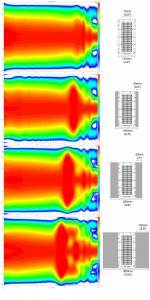
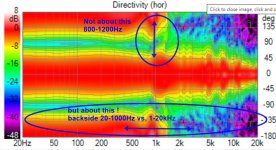
Anyway it's important that the summed sound power radiated backwards is almost same, this will affect room decay. Without backside radiation treble sounds different than lower registers. This happens even with "normal" speakers with deep and wide horn speakers. Small differences in radiation pattern are not really important.
Wide open baffle speakers have rather wide range of almost omnipole radiation. That's why I can't call them dipoles. It's difficult to find full 360deg polars of them, I guess designers know that they wouldn't look good... Even Magnepan LRS isn't good


Last edited:
That Magnepan LRS isnt a good dipole example. Below is the Sanders ESL showing the expected dipole:Even Magnepan LRS isn't good
Subscribed! I have wondered about this driver for OB midrange as well, but focused elsewhere now. Also using Acourate and 4-way system.
The Dipole18 can go up to 300Hz, per John at AE. The challenge is you are running them in mono and shouldn't do that to 300Hz. I also have mono (sealed) subs below 80Hz. If the goal is to reduce tge size of the speakers, maybe keep the 18" but as midbasses in a small panel and get smaller sealed subs you can distribute in the room and blend into the decor? And visually keep a tweeter, midrange and the 18" per side...just a thought.
FWIW, this is similar to where I'm headed: 4 sealed 12" subs to 70Hz, now have 18" Faitals that I'm evaluating a change to AE LO15, 8" mids and large AMT tweeter from 1.2kHz. Revisiting mids will come after I settle on the midbass.
The Dipole18 can go up to 300Hz, per John at AE. The challenge is you are running them in mono and shouldn't do that to 300Hz. I also have mono (sealed) subs below 80Hz. If the goal is to reduce tge size of the speakers, maybe keep the 18" but as midbasses in a small panel and get smaller sealed subs you can distribute in the room and blend into the decor? And visually keep a tweeter, midrange and the 18" per side...just a thought.
FWIW, this is similar to where I'm headed: 4 sealed 12" subs to 70Hz, now have 18" Faitals that I'm evaluating a change to AE LO15, 8" mids and large AMT tweeter from 1.2kHz. Revisiting mids will come after I settle on the midbass.
My experience tells that lowering ears is more effective than lowering source! Furniture specially sofas will effectively kill horizontal flutter. But at same time vertical mode's phase sum changes, and that might do good or bad.
The Greek study was done in 3 halls, smallest 6x8m. Every hall had quite high level of EDT etc. Typical home rooms are much better and as per my experience, handclaps will reveal only really bad cases. Learning will help for this obviously.
EDT is not always same, here are my MMM, 4 measurements per speaker L+R separately. One per speaker is from knee level, one above my head. I suppose lowest EDT of mid-high F comes when mic is low. SPL response shows variation too (500ms 1/12), notice that modal frequencies remain same.
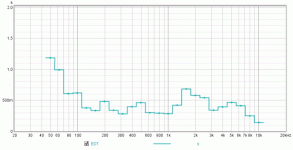
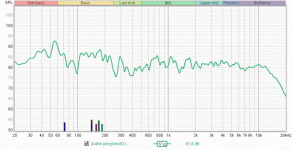
The Greek study was done in 3 halls, smallest 6x8m. Every hall had quite high level of EDT etc. Typical home rooms are much better and as per my experience, handclaps will reveal only really bad cases. Learning will help for this obviously.
EDT is not always same, here are my MMM, 4 measurements per speaker L+R separately. One per speaker is from knee level, one above my head. I suppose lowest EDT of mid-high F comes when mic is low. SPL response shows variation too (500ms 1/12), notice that modal frequencies remain same.


Unfortunately my project was delayed while I figured out how to configure the bass section, and then winter hit. Since I need to make outdoor measurements I have to wait until the weather permits this, which around here will not be until April at least. This doesn't impact how I feel about the PTT6.5M. It's superior IMD performance puts it head and shoulders above other drivers as a wide band midrange in my nude OB designs.
Same here for other reasons.
Unfortunately I'm at the moment very occupied with renovation work in our house, so I do not find the time for experiments, measurements etc.
My complete hifi equipment will be moved to another place in our house, but the new room is not yet ready 😳
However, I did not stop thinking about future solutions for my open baffle system, which of course include ideas with Purifi drivers.
My goal is and will be to have a system with a very good horizontal directivity. That means, that driver size and baffle size have to be chosen properly for the dedicated frequency range.
It is imho obvious, that current Purifi drivers could be only used for upper bass and midrange.
Even the PTT8 with Sd=235cm² and Xmax=9,3mm is to small for the lowest octave. It is easy to calculate, how much of them would be needed to replace my current AE Dipole 18 (1218cm²/15mm).
But it could be a great driver in a typical 4-way OB to be used for the upper bass and lower midrange.
There are many 4-way OB concepts using a driver of this size in this range.
On the other side, I love the idea of downgrading to a 3-way system, by using a driver, which is small enough to be crossed over to a tweeter at about 2khz, still keeps very good directivity, but has enough volume displacement to reach down to e.g 300-400Hz, which I think would be the maximum for the Dipole 18 as a naked driver (again keeping a very good constant directivity).
@CharlieLaub: Do you think, the PTT6.5 would be appropriate for this? Or some PTT6.5X? Maybe two of them as MTM?
I'm a little bit afraid, that the directivity of these drivers is already compromised at 2kHz, as they already start to beam somewhere between 1 and 2 KHz. Or is the level of beaming still low enough there?
What frequency range have you planned for this driver as a naked midrange in your system?
Best regards
Matthias
Unfortunately I'm at the moment very occupied with renovation work in our house, so I do not find the time for experiments, measurements etc.
My complete hifi equipment will be moved to another place in our house, but the new room is not yet ready 😳
However, I did not stop thinking about future solutions for my open baffle system, which of course include ideas with Purifi drivers.
My goal is and will be to have a system with a very good horizontal directivity. That means, that driver size and baffle size have to be chosen properly for the dedicated frequency range.
It is imho obvious, that current Purifi drivers could be only used for upper bass and midrange.
Even the PTT8 with Sd=235cm² and Xmax=9,3mm is to small for the lowest octave. It is easy to calculate, how much of them would be needed to replace my current AE Dipole 18 (1218cm²/15mm).
But it could be a great driver in a typical 4-way OB to be used for the upper bass and lower midrange.
There are many 4-way OB concepts using a driver of this size in this range.
On the other side, I love the idea of downgrading to a 3-way system, by using a driver, which is small enough to be crossed over to a tweeter at about 2khz, still keeps very good directivity, but has enough volume displacement to reach down to e.g 300-400Hz, which I think would be the maximum for the Dipole 18 as a naked driver (again keeping a very good constant directivity).
@CharlieLaub: Do you think, the PTT6.5 would be appropriate for this? Or some PTT6.5X? Maybe two of them as MTM?
I'm a little bit afraid, that the directivity of these drivers is already compromised at 2kHz, as they already start to beam somewhere between 1 and 2 KHz. Or is the level of beaming still low enough there?
What frequency range have you planned for this driver as a naked midrange in your system?
Best regards
Matthias
@Matty I did some measurements of the PTT midrange in the late fall, with the driver nude and suspended above the ground by about 2.5m and measurements done at 0.5m. I measured a few angles from front and rear sides. These are attached. I have also included a plot that compared the "on axis" curves taken in front of (0 deg), and behind (180 deg) the driver. The directivity is relatively stays controlled both in front and back, but overall the response families are different. To the rear the responses all fall off faster above about 1.7kHz compared to in front of the driver. It's not a big deal, but as a result I will cross over to the tweeter around there. If you cross over higher than this and use the front response as a basis for your response, there will be a bit of a hole to the rear up to about 6dB deep. The other area that needs careful attention is the peak around 1.3kHz since it is relatively "peaky" and likely not simple to flatten out.
Attachments
for WAF the Slob of NP can be good ,the AE hidden ,purifi 8" Alu to 800/900 , 12MUscan (only too 2100?)+ twThe whole system works very well at the moment, however, for non-technical reasons (WAF among other things 😊) I would like to downgrade a little bit. 3-Way would be fine,
best regards
Matthias
View attachment 1094942
(On the picture the speaker is not at the listening position, as we are rearranging the living room at the moment.)
still 4way but elegant
- Home
- Loudspeakers
- Multi-Way
- Purifi Drivers for Open Baffle
